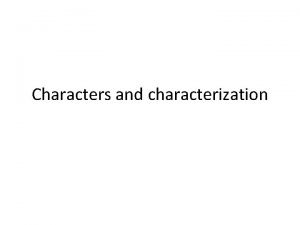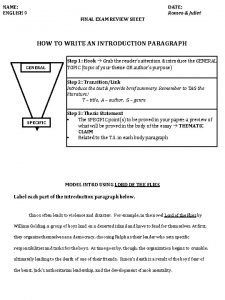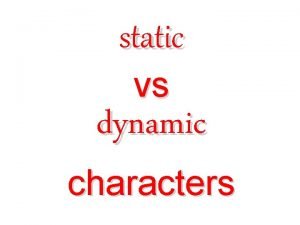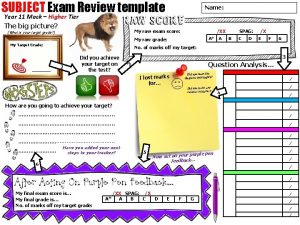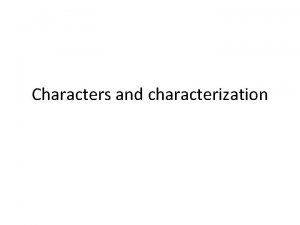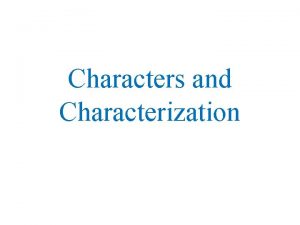CHARACTERS AND CHARACTERIZATION EXAM REVIEW CHARACTERIZATION Characterization is








- Slides: 8

CHARACTERS AND CHARACTERIZATION EXAM REVIEW

CHARACTERIZATION Characterization is the way that writers develop characters in a story This is done in two ways: 1. Direct characterization 2. Indirect characterization

CHARACTERIZATION Direct characterization is when the writer directly tells the reader what a character is like. Indirect characterization is when the writer gives the reader clues about what the character is like by describing how the character acts, thinks, and what other characters think about them. The writer allows the reader to decide how to view the character.

CHARACTERS 1. Protagonist: The protagonist is the main character of a story. Ex: Elie (Night), Jonas (The Giver), Tris (Divergent), Katniss (The Hunger Games) 2. Antagonist: The antagonist is the character in the story that the protagonist struggles against. Ex: Nazis (Night), Jeanine (Divergent), Peter (Divergent), President Snow (The Hunger Games)

CHARACTERS 3. Minor characters: These are characters who may or may not play major roles in the story. Ex: Ron Weasley (Harry Potter), Hermione Granger (Harry Potter), Asher (The Giver), Gale (The Hunger Games), Four (Divergent), Shlomo (Night)

CHARACTER MOTIVATION Character motivations are the reason or reasons why a character does something in a story. Ex: Jonas wants to escape from the Community so that his memories will pass on to the other citizens. Ex: Elie wants to stay with his father throughout the concentration camps because he does not want to lose the last member of his family. Ex: Katniss wants to save Peeta so that they can both become victors and return to District 12.

TYPES OF CHARACTERS 1. Round Characters: Round characters are well -developed characters. The author tells the reader a lot about the character. 2. Flat Characters: Flat characters are not as well-developed and readers do not know very much about them. Minor characters are often flat characters.

TYPES OF CHARACTERS 3. Dynamic Characters: Dynamic is a word that means “changing. ” A dynamic character is one who changes during the course of a story and often the change involves learning a major lesson. 4. Static Characters: A static character is one who does not change or change much during the story.
 Writ of certiorari ap gov example
Writ of certiorari ap gov example What is a composite character
What is a composite character Final exam review packet spanish 1 and spanish 2 answer key
Final exam review packet spanish 1 and spanish 2 answer key Romeo and juliet exam review
Romeo and juliet exam review Dynamic character and static character
Dynamic character and static character World history spring final exam review answers
World history spring final exam review answers You template
You template Spanish 1 final review
Spanish 1 final review Pltw human body systems final exam review
Pltw human body systems final exam review

